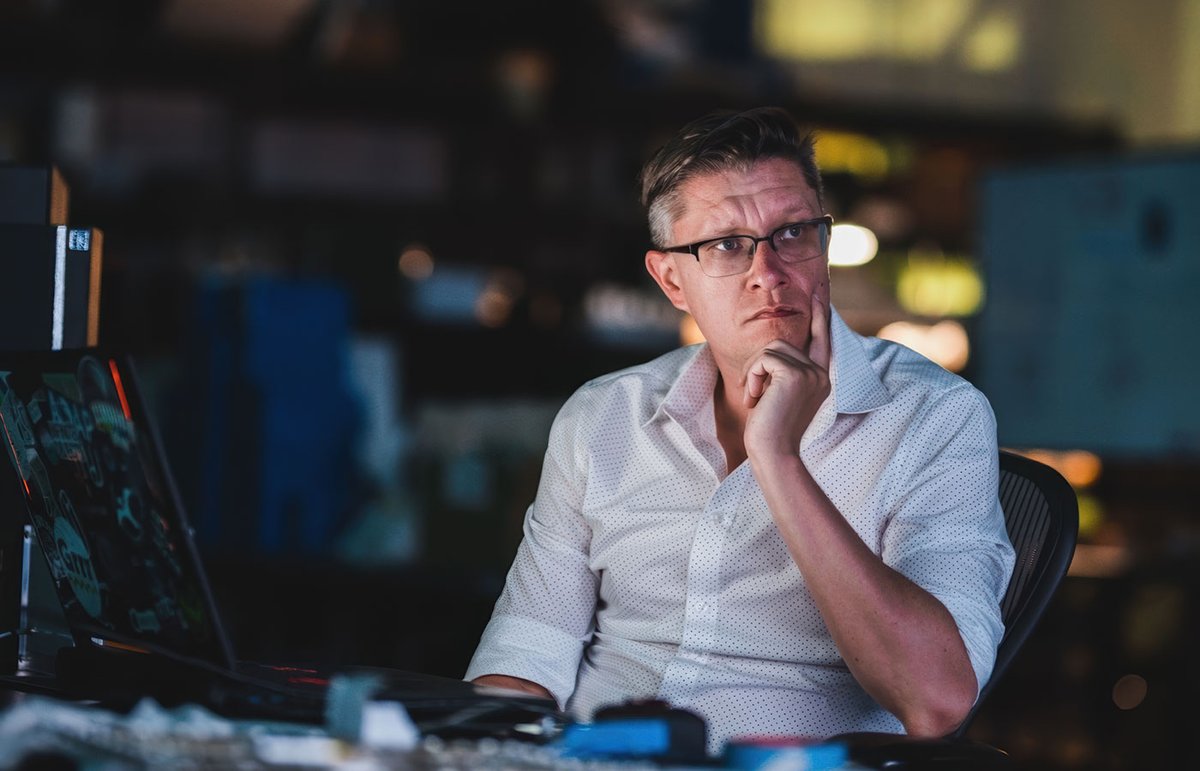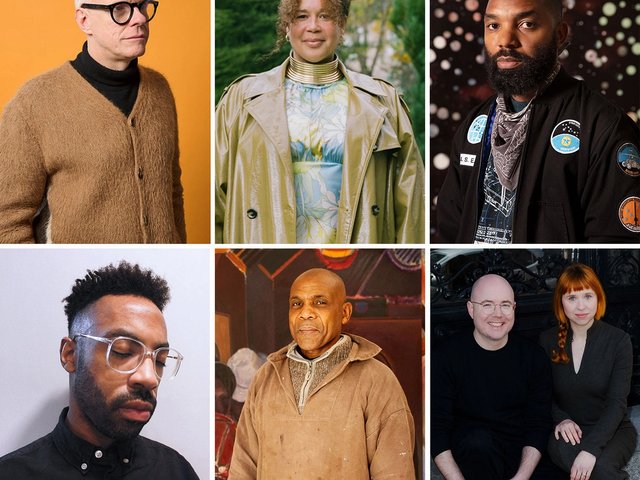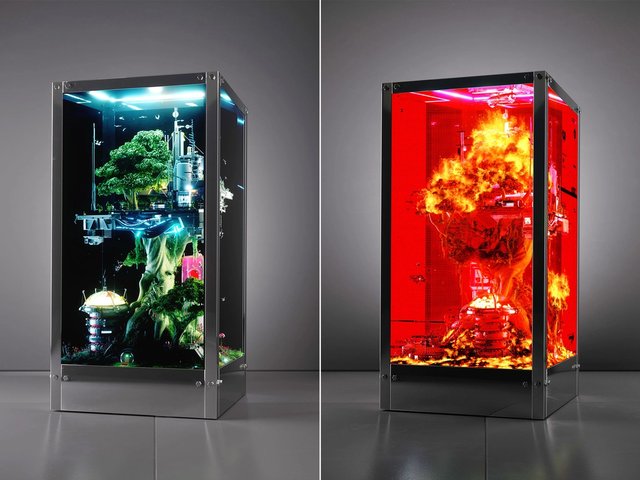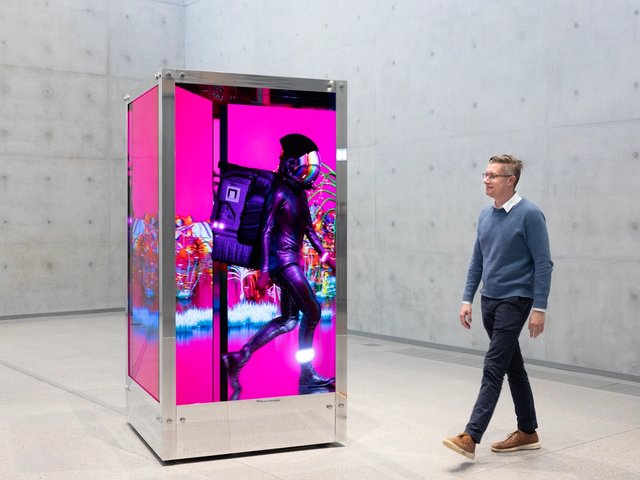The digital artist Mike Winkelmann, better known as Beeple, is quick-witted, ebullient and easy company. Last year at a mid-sized dinner for technology practitioners, curators and writers in a London restaurant, he easily held the table with his anecdotes and insights. He laughs and smiles readily, but he is nothing if not thoughtful. When asked on a recent video call how he manages his daily news-related visual posts (his Everydays)—at a time when one world leader in particular is “flooding the zone” with distracting information—he answers at once, but with head tilted in thought and his square-spectacle-framed eyes raised up in professorial concentration.
The South Carolina-based artist, a native of Wisconsin, has been on a questing, thought-filled, journey since his Everydays: the First 5,000 Days broke art auction records for NFT (non-fungible token) art—and the internet’s collective mind—a little over four years ago. Part of that quest has seen him create a growing body of interactive video sculptures and develop into a media artist who increasingly views his social media posts as a form of public art: one that can serve up daily satire while at the same time delivering ways to save the planet and a nuanced take on what is signal and what is noise in an increasingly fraught media environment.
The $69.3m Everydays jpeg earned its currency from the artist’s daily process, one launched in 2007, of posting every day, as he still does, on social media, in a practice aimed at improving as an artist. Six months after the Everydays auction, Beeple sold a kinetic video sculpture, Human One, at Christie’s New York, in November 2021, to the leading digital art collector Ryan Zurrer for $29m (including fees). Human One—in which an astronaut-like figure projection-mapped onto four-sided, rotating, phone-kiosk scaled screens, ambles rhythmically through a dystopian landscape, in a perpetual looping sequence—has been on a global tour almost ever since, organised by Zurrer’s collection 1OF1.
The first museum show was at Castello di Rivoli in Turin (with Human One placed in dialogue with Francis Bacon’s Study for Portrait IX (1956-57) before the work was exhibited at M+, Hong Kong; at Crystal Bridges Museum of American Art, in Bentonville, Arkansas (where the artist successfully updated both its background and its main figure live in front of its owner and a watching audience); as part of Beeple’s first solo museum exhibition, Tales from a Synthetic Future, curated by Hans Ulrich Obrist at Deji Art Museum in Nanjing, China; and now, until 8 June, in an exhibition at the Mori Museum, in Tokyo.
This month, two more of Beeple’s interactive video sculptures—The Tree of Knowledge (2024) and Diffuse Control (2025)—are going on public show. The former as part of the first iteration of the South by Southwest London (SXSW London) festival of music, tech, cinema, fashion and art, in Shoreditch, east London; the latter, which allows interaction from curators (feeding new images into the generative art piece) and from visitors using a phone app, at The Shed in Midtown Manhattan.
Both sculptures, like Human One before them, are interactive, generative, works that the artist can develop, with their owners’ collaboration, for the rest of his creative life. This marks a new kind of relationship between artist and owner, he says, but also between owner, artist and public. (There is one other version of The Tree of Knowledge, which was shown at Italian Tech Week in Turin. It was bought by Lingotto Investment Management—with the proceeds going to non-profit initiatives supporting food justice and the protection of millions of acres of land and sea—and can be viewed by appointment in the lobby of Lingotto’s New York City office.)
At SXSW London, The Tree of Knowledge will form part of "SXSW LDN LAB”, an exhibition at Protein Studios curated by Alex Poots, the artistic director of The Shed, in company with an installation of video work by Andy Warhol (curated by Patrick Moore, a board member of SXSW London and the former executive director of the Andy Warhol Museum in Pittsburgh); an installation by the musicians and ground-breaking AI (artificial intelligence) artists Holly Herndon and Mat Dryhurst; and an artist interview conducted by Hans Ulrich Obrist, artistic director of Serpentine Galleries.
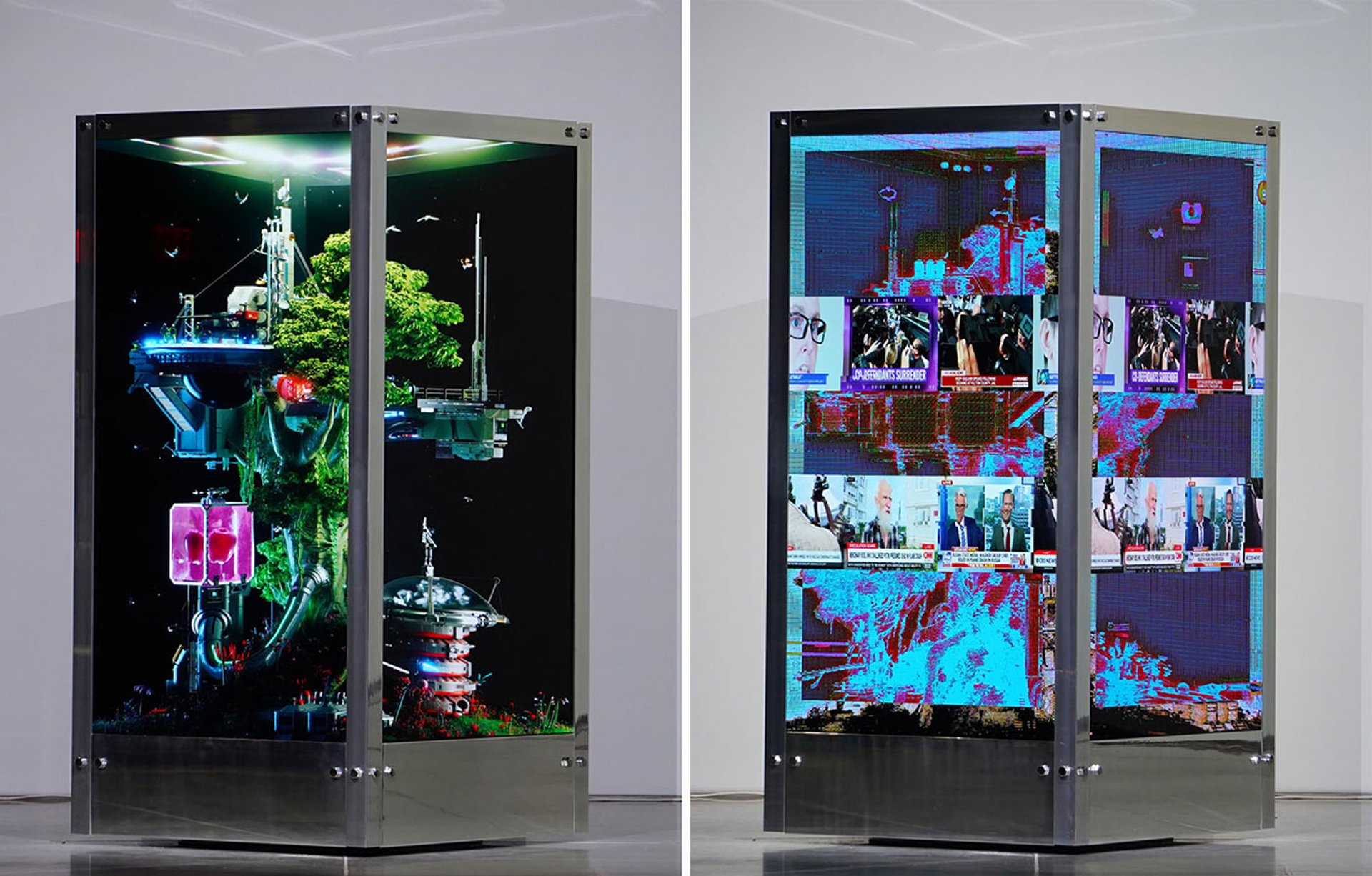
Signal and Noise: Beeple's sculpture The Tree of Knowledge (2024) in "Signal" mode (left) and "Noise" mode. In the latter, news feeds and other images symbolic of media overload obscure the view of the tree itself © Beeple Studios
The idea behind The Tree of Knowledge, Beeple tells The Art Newspaper, “is that we live in a world where we’re inundated with media and a 24-hour news cycle and there’s just so much information coming in. There’s this immediate impending doom and anxiety. But a lot of that we actually can control and tune out.” We can put our phones down, he says, “and chill out for a second and go take a walk. It’s still there. But we’re making it work on some level, we’re co-existing with technology.” The interactivity in The Tree of Knowledge comes from a dial on a console that stands in front of the sculpture. The viewer can turn it to “Signal” or “Noise”. Turn to Noise and the sculpture is flooded with media noise, of clips, posts and news bulletins. “When you turn it to Signal,” Beeple says, “it becomes this very peaceful, serene thing.”
The Tree of Knowledge, he says, is trying to offer “a more nuanced take on our relationship with technology, in that it is not good or bad”. He hopes viewers will take away the idea “that they do have a choice with how much information they’re letting in.” It is a message, he says, that he needs “just as much as anybody”. Asked how his topical, often satirical, Everyday posts are faring in the news tsunami of the second Trump presidency, he says “We're all on the roller coaster. There's no getting off now. It’s a four-year ride. And we're in the first inning of this thing. I think everybody needs to pace themselves. So there's no shortage of inspiration for the Everydays lately, let's just say that.”
Beeple says he feels honoured to be exhibited with Warhol, Obrist, Herndon and Dryhurst at SXSW London. The Warhol installation, he says, “speaks to a continuation of media art and technology”. He feels “very fortunate”, he says to be “creating now with the tools that we have. There are so many different things and so many different ways to interact and communicate. I think it's cool to see the lineage” working back to what “Warhol was trying to do with 50-years-back technology.”
Moore says that the exhaustion with media that Beeple addresses is resonant with Warhol's legacy. “If you think of Warhol's car-crash paintings, for example, the lurid tabloid images repeated across the canvas until often there's just a void at the bottom. That, for me, is resonant with the idea of an exhaustion with media”. But perhaps the biggest connection, Moore says, is “that we can't really discover unless we also look backward at the same time. So the idea that [Warhol] was really committed to breaking down boundaries between different types of cultural production, the fact that he was a successful painter and he picked up a camera and said, I'm not going to paint anymore, even though that was a lie. Those types of things are so rich, if we look at them, but also connect them to contemporary artists who are making work in the present moment.”
Art is “for asking questions”
The historical practitioners Beeple most admires include Warhol, Marcel Duchamp, Jackson Pollock, Mark Rothko, Piet Mondrian and Pablo Picasso. All of them, he says, “showed us a new way of looking at the world, a new way of looking at life”.
Talking of Warhol’s inspiration, Beeple says that he has been looking at social media “through a different lens, that of public art. Social media is that to the next level because it's free art. Everybody can look at it. Everybody can comment and interact with it. And I think, through that lens, it takes on a new sort of meaning. So many of the themes that [Warhol] talked about in terms of celebrity culture and everybody having their 15 minutes of fame have proven to be correct and very prescient.” Beeple mentions instances where “I've made pictures about people and then those people have commented on the pictures.” And muses how it might have been if Warhol had been able to get instant feedback from the subjects of his celebrity portraits. A “crazy thing”.
Asked what he thinks art is for, Beeple says it is “for asking questions”. “I’m always trying to ask more questions and bring up more possibilities and new ways of looking at the world. And I think that’s what the best art does. It just presents a different lens through which to view the world.” He adds: “What I’m trying to do is make something that you’ve never seen before. If you can do that, your work will stand the test of time. That’s what I’m at least attempting to do.”
- Beeple, The Tree of Knowledge, as part of SXSW London, 2-7 June, Protein Studios, 31 New Inn Yard, Shoreditch, London
- Diffuse Control, free to view from 27 June, The Shed’s Doctoroff Lobby, 545 West 30th Street, New York City
- Human One, as part of Machine Love: Video Game, AI and Contemporary Art, Mori Art Museum, Tokyo, until 8 June


